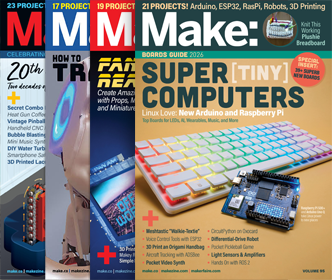HOW TO – Install a touchscreen for Linux
 IBM has some great articles lately – “Historically, the lack of friendly interfaces has been an obstacle to making Linux a commercially viable product for end users, but with available GUIs, that’s yesterday’s news. What’s the next step in creating an easy-to-use Linux-based product for consumers? Imagine adding a user-oriented LCD touchscreen. A touchscreen facade can make back-end Linux applications very usable in such devices as custom digital media centers (either in the home or in automobiles), DVRs and PVRs, and even control interfaces for household robots. The potential uses are limited only by the imagination. In this article, get an overview for installing an LCD taken from a Sony PSOne, creating a modeline, and installing a touchscreen — all for Linux.” Thanks Donald! Link.
IBM has some great articles lately – “Historically, the lack of friendly interfaces has been an obstacle to making Linux a commercially viable product for end users, but with available GUIs, that’s yesterday’s news. What’s the next step in creating an easy-to-use Linux-based product for consumers? Imagine adding a user-oriented LCD touchscreen. A touchscreen facade can make back-end Linux applications very usable in such devices as custom digital media centers (either in the home or in automobiles), DVRs and PVRs, and even control interfaces for household robots. The potential uses are limited only by the imagination. In this article, get an overview for installing an LCD taken from a Sony PSOne, creating a modeline, and installing a touchscreen — all for Linux.” Thanks Donald! Link.




 Handy open source app (Mac) – “I wanted to be able to listen to the songs on my iPod for some time now. This is because I don’t want to fill up the hard-drive of my iBook with music, but be able to access my Music when I’m on the way. I found some solutions but none really made me happy. Then I found mt-daapd which did exactly what I wanted except for one thing. mt-daapd can export any folder as an iTunes-music-share. The missing piece was, that it doesn’t detect if an iPod is connected. So I wrote a simple programm that detects if an iPod is connected and then automatically shares it with mt-daapd.”
Handy open source app (Mac) – “I wanted to be able to listen to the songs on my iPod for some time now. This is because I don’t want to fill up the hard-drive of my iBook with music, but be able to access my Music when I’m on the way. I found some solutions but none really made me happy. Then I found mt-daapd which did exactly what I wanted except for one thing. mt-daapd can export any folder as an iTunes-music-share. The missing piece was, that it doesn’t detect if an iPod is connected. So I wrote a simple programm that detects if an iPod is connected and then automatically shares it with mt-daapd.” 
 Very cool how-to, the Maker writes “I first thought electrostatic headphones were a joke. It didn’t sound safe to strap high voltage transducers to your head. But after my work with electrostatic loudspeakers I had the skill and knowledge to try building a pair and listening to them.” [
Very cool how-to, the Maker writes “I first thought electrostatic headphones were a joke. It didn’t sound safe to strap high voltage transducers to your head. But after my work with electrostatic loudspeakers I had the skill and knowledge to try building a pair and listening to them.” [
 Last week was Doppler’s birthday, Creative Digital Music has a tribute featuring where to learn more about the Doppler effect, and how it applies to astrophysics (but NOT the expansion of the universe), and how to reproduce it in software like Pro Tools. Now if someone can just come up with a good recipe for the Dopplertini. Definitely shaken.
Last week was Doppler’s birthday, Creative Digital Music has a tribute featuring where to learn more about the Doppler effect, and how it applies to astrophysics (but NOT the expansion of the universe), and how to reproduce it in software like Pro Tools. Now if someone can just come up with a good recipe for the Dopplertini. Definitely shaken. 
 Peter writes “
Peter writes “
 Omegas writes in about the DIY Minimoog – “If you want to get started with analog synth building but Minimoog seems too complicated, see the instructions at
Omegas writes in about the DIY Minimoog – “If you want to get started with analog synth building but Minimoog seems too complicated, see the instructions at 
 Excellent project – “After playing on many different synths and copying several designs. I decided that I had to have a minimoog… Unfortunately the cost of a second hand minimoog is anything between 1000-2000 Euros depending on age and condition. So the only choice I have is to look at doing my own copy with the aim of keeping the circuits and design as original as possible. Having never played one, or seen one until a few months ago I have managed to amass a reasonable collection of circuits and pictures in order to help me in my quest.” [
Excellent project – “After playing on many different synths and copying several designs. I decided that I had to have a minimoog… Unfortunately the cost of a second hand minimoog is anything between 1000-2000 Euros depending on age and condition. So the only choice I have is to look at doing my own copy with the aim of keeping the circuits and design as original as possible. Having never played one, or seen one until a few months ago I have managed to amass a reasonable collection of circuits and pictures in order to help me in my quest.” [